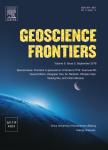Australasian microtektites across the Antarctic continent: Evidence from the Sør Rondane Mountain range (East Antarctica)
Australasian microtektites across the Antarctic continent:Evidence from the S?r Rondane Mountain range(East Antarctica)作者机构:AnalyticalEnvironmentaland Geo-ChemistryVrije Universiteit BrusselPleinlaan 2BE-1050 BrusselsBelgium Laboratoire G-TimeUniversitéLibre de Bruxelles 50Av.F.D.Roosevelt CP 160/02BE-1050 BrusselsBelgium Centre for Astrophysics and Planetary ScienceUniversity of KentCT27NZCanterburyKentUnited Kingdom Atomic&Mass Spectrometry–A&MS Research UnitDepartment of ChemistryGhent UniversityCampus SterreKrijgslaan 281–S12BE-9000 GhentBelgium Electrochemical and Surface EngineeringVrije Universiteit BrusselPleinlaan 2BE-1050 BrusselsBelgium
出 版 物:《Geoscience Frontiers》 (地学前缘(英文版))
年 卷 期:2021年第12卷第4期
页 面:202-214页
核心收录:
学科分类:070903[理学-古生物学与地层学(含:古人类学)] 0709[理学-地质学] 07[理学] 0708[理学-地球物理学] 0705[理学-地理学] 070501[理学-自然地理学] 0704[理学-天文学]
基 金:the Research Foundation Flanders (FWO)for funding this PhD research to BS the support by the Belgian Science Policy (BELSPO) through BELAM,Amundsen and BAMM projects the Research Foundation-Flanders (FWO–Vlaanderen) and the VUB strategic research the support from the FWO–FNRS “Excellence of Science (EoS)” project ET–Ho ME (ID30442502) the FRS–FNRS for support
主 题:Impact cratering Impact ejecta Target stratigraphy Volatilization Antarctica Microtektites
摘 要:The~790 ka Australasian(micro)tektite strewn field is one of the most recent and best-known examples of impact ejecta emplacement as the result of a large-scale cratering event across a considerable part of Earth s surface(10%in area).The Australasian strewn field is characterized by a tri-lobe pattern consisting of a large central distribution lobe,and two smaller side lobes extending to the west and ***,we report on the discovery of microtektite-like particles in sedimentary traps,containing abundant micrometeorite material,in the Sør Rondane Mountain(SRM)range of East *** thirty-three glassy particles display a characteristic pale yellowcolor and are predominantly spherical in shape,except for a single dumbbell-shaped *** vitreous spherules range in size from220 to 570μm,with an average diameter of~370μ*** compares relatively well with the size distribution(75–778μm)of Australasian microtektites previously recovered from the TransantarcticMountains(TAM)and located ca.2500–3000 km fromthe *** addition,the chemical composition of the SRM particles exhibits limited variation and is nearly identical to the‘normal-type’(i.e.,6%MgO)TAM *** Sr and Nd isotope systematics for a single batch of SRM particles(n=26)strongly support their affiliation with TAMmicrotektites and the Australasian tektite strewn field in ***,Sr isotope ratios and Nd model ages suggest that the target material of the SRM particles was composed of a plagioclase-or carbonate-rich lithology derived from a Paleo-or Mesoproterozoic crustal *** affiliation to the Australasian strewn field requires long-range transportation,with estimated great circle distances of ca.11,600 km from the hypothetical source crater,provided transportation occurred along the central distribution *** is in agreement with the observations made for the Australasian microtektites recovered from Victoria Land(ca.11,000 km)and Larkman Nunatak(ca.12,000 km),w



